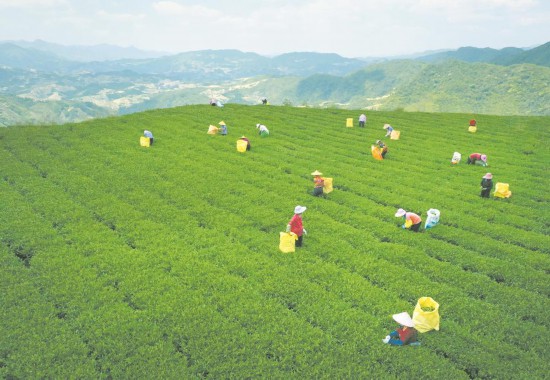China boosts rural industries, diversifies channels to increase farmers’ incomes
Thanks to the implementation of government policies aimed at boosting agriculture and benefiting farmers, China has seen a boom in its rural industries through multiple means, diversifying channels to increase the income of the country’s farmers.

Tea farmers busy picking tea leaves in Anxi county, southeast China's Fujian Province. (Photo/Fu Xiaoqing)
In the first three quarters of 2021, the per capita disposable income of China’s rural residents stood at 13,726 yuan (about $2,154), up 11.2 percent in real terms.
China has improved its agricultural management system to help farmers stabilize production and increase their operating incomes. At present, there are more than 3 million family farms and 2.4 million farmers’ cooperatives in the country, helping 100 million farming households continuously tap into the potential of continued income growth. Besides, 90,000 leading agricultural companies across China have helped 125 million smallholder farming households to embrace modern agriculture.
China has also set up more than 900,000 agricultural socialized service organizations, including 440,000 ones, to which 60 million farmer households entrust the farming of 1.5 billion mu of their land, laying a solid guarantee for agricultural production.
Famous for its tea industry, Anxi county in southeast China’s Fujian Province is home to 600,000 mu (40,000 hectares) of tea plantations, and tea leaves have become an important source of income for local farmers.
The county has promoted a business model that integrates industry associations, companies, cooperatives and farmers, optimized the tea-making process, and further improved the quality of tea, ensuring that high-quality tea can sell at a decent price, said Xie Jingxin, deputy director at the agriculture and rural affairs bureau of Anxi county.
According to Xie, Anxi has established more than 1,200 cooperatives covering tea planting, tea making and sales, including 34 leading tea companies, helping over 800,000 tea growers in the county to increase their incomes. The total output value of the county’s tea industry has reached 20 billion yuan.
These cooperatives provide one-stop services ranging from the management of tea gardens to the purchase of tea leaves and teaching tea growers planting technologies, facilitating the standardized production of tea and boosting the tea industry.
Chen Binghuai, a tea grower in the county’s Juyuan village, has been enjoying the benefits of the thriving tea industry. Last year, Chen earned over 200,000 yuan from his 26 mu of tea gardens. “The price of tea leaves increased 20 percent from a year ago. Thanks to the help of cooperatives, we can secure a stable income and don’t need to worry about market risks,” Chen said.
Seizing the opportunity for the pilot reforms of China’s rural collective property rights system, Wuhui village in Deyang city, southwest China’s Sichuan Province, established a cooperative, to which farmers voluntarily transferred their farmland. The village then transferred the use rights of the collective land to the Deyang branch of the Chengdu rural property rights exchange.
“After the reform, we earned a rental income of up to 1,150 yuan per mu, up from 850 yuan per mu. Besides, after preparing and tidying up the land transferred from farmers, the total area of land increased by 310 mu,” said Liu Yang, Party chief of the village.
Liu introduced that the village distributed the added value of the land back to each household who transferred their land in the form of dividends while including the rental income from the additional 310 mu received for the land into the village’s collective development funds.
After the land transfer, the village planted grain on some 4,000 mu of land, increasing the yield per mu by 7 to 8 percent, as well as growing vegetables, fruits and flowers on the rest of the land. According to statistics, the average income of each household increased by 20 percent thanks to the land transfer.
Taking advantage of local resources, Chinese local governments have extended the agricultural industry chain and promoted the integrated development of the primary, secondary, and tertiary industries, enabling farmers to work near their homes and increase their incomes.
In the first three quarters of 2021, the processing industry for agricultural and sideline products above the designated size increased by 8.6 percent year-on-year, while rural tourism meanwhile had basically recovered to the same level achieved during the period in 2019. Online retail sales of farm produce maintained double-digit growth.
Meanwhile, China has developed 50 clusters of advantageous industries featuring local characteristics, 151 national modern agricultural industrial parks, 228 demonstration parks for integrated industrial development in rural areas, and 811 towns with strong agricultural industries.
Photos
Related Stories
- County in Hainan boosts tourism to promote rural vitalization
- Mountainous county in E China's Jiangxi thrives thanks to smart logistics
- Xi's top agenda in 2021: Rural vitalization
- Small town in E China’s Zhejiang knits together success with woolen clothing, marches toward common prosperity
- Farmer-turned-entrepreneur sprouts big business from small potatoes
Copyright © 2022 People's Daily Online. All Rights Reserved.










